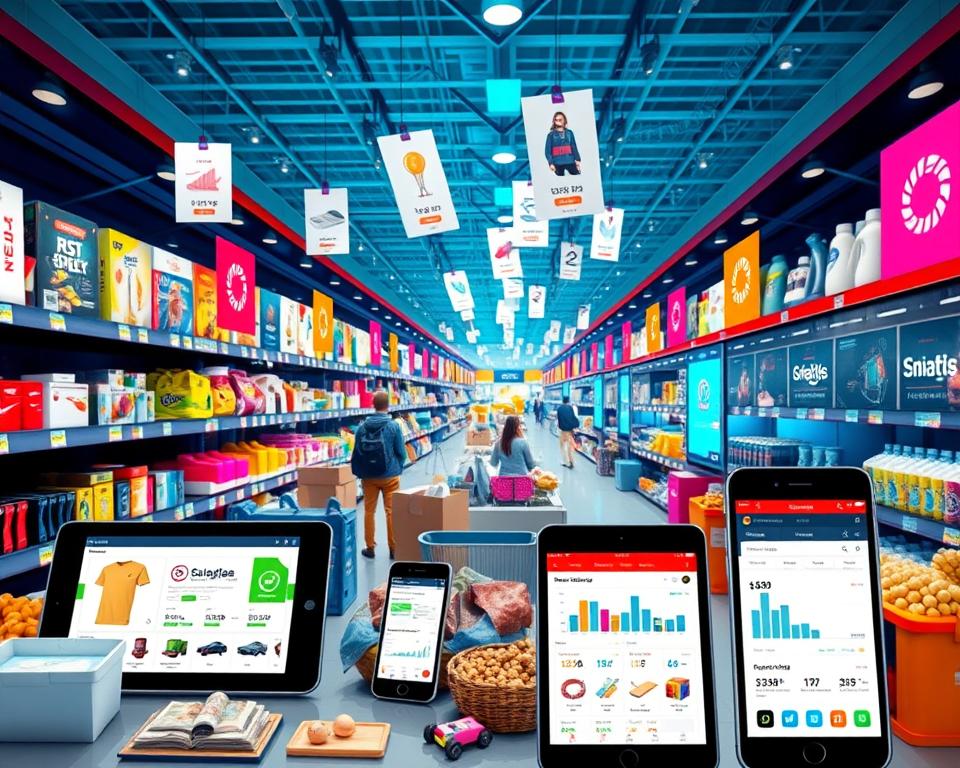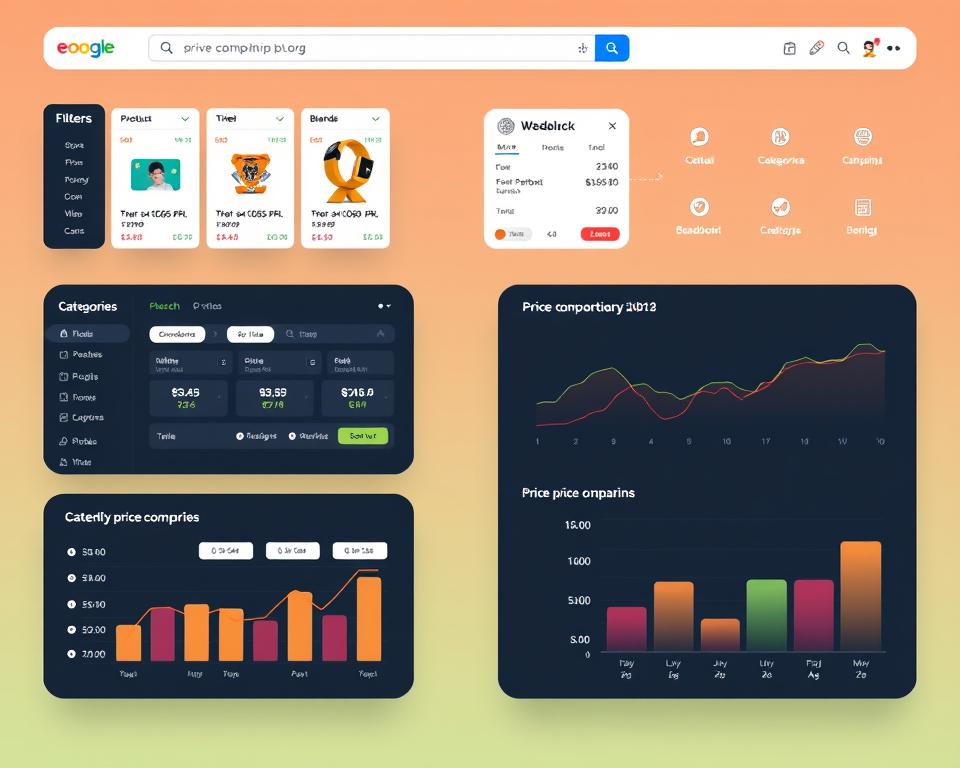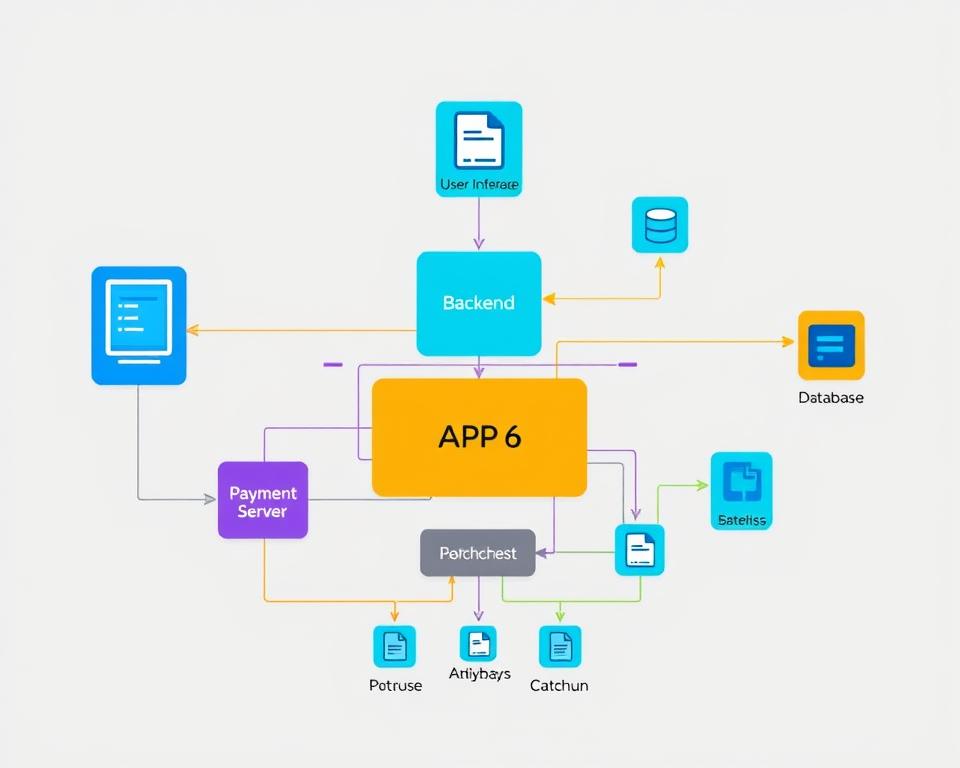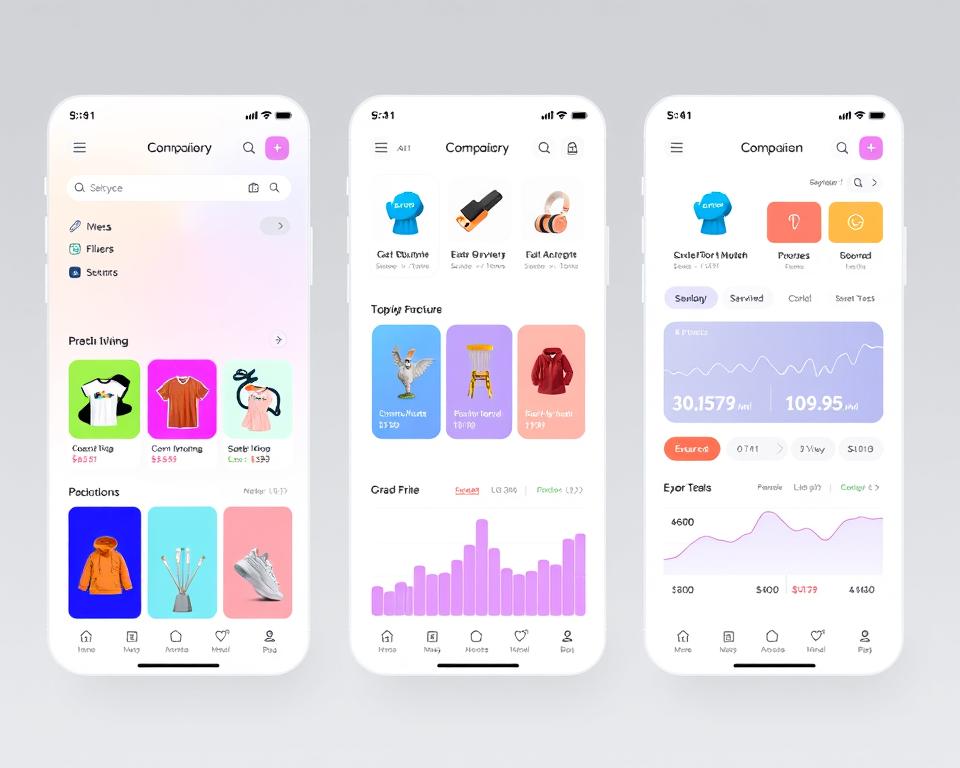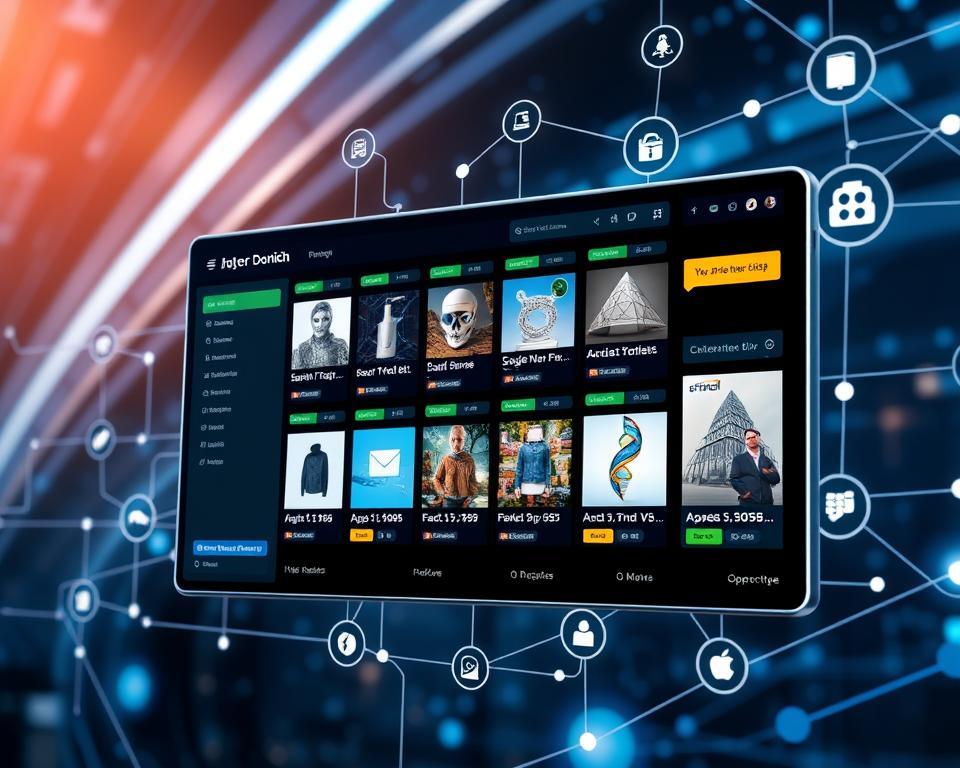In today’s world, people are more focused on prices than ever before. This makes building a price comparison app very important for businesses. It’s like creating a tool similar to PriceGrabber. This guide will show you how to make a price comparison app that helps users buy smartly and boosts sales for sellers.
Table of Contents
Key Takeaways
- Understand the price comparison app market landscape, including current market leaders and their success factors, market size, and target audience analysis.
- Identify the essential features required for a comprehensive price comparison platform, such as product search, filtering, and real-time price updates.
- Explore the technical requirements and architecture planning, including backend infrastructure, database design, and API integration.
- Learn about data scraping and product information collection methods, including web crawling techniques and data validation processes.
- Discover the importance of user interface design, search algorithm development, and payment gateway integration for a seamless user experience.
Understanding the Price Comparison App Market Landscape
The price comparison app market has grown a lot in recent years. This growth is due to more people shopping online and changing how they shop. Apps like PriceGrabber, Google Shopping, and ShopStyle are now top choices for those looking for deals.
Current Market Leaders and Their Success Factors
PriceGrabber leads by having a vast product list, easy filters, and updates in real-time. Google Shopping is a big name thanks to its huge product catalog and easy integration with Google. ShopStyle stands out by focusing on fashion and lifestyle, offering a special shopping experience.
Market Size and Growth Potential
The market for price comparison apps is set to grow even more. This growth comes from more people shopping online and wanting to know prices clearly. Experts say the global market could hit $XXX billion by 20XX, growing at XX% each year.
Target Audience Analysis
These apps appeal to many, from tech-loving millennials to those watching their budgets. Knowing what these users want and need is key to making a successful app. This way, the app can grab a big part of the market.
| Key Audience Segments | Characteristics | Motivations |
|---|---|---|
| Price-conscious Consumers | Primarily focused on finding the best deals and lowest prices | Seeking to maximize their purchasing power and minimize spending |
| Tech-savvy Millennials | Comfortable with mobile technology and digital shopping experiences | Prioritize convenience, personalization, and seamless user experiences |
| Bargain Hunters | Actively seek out discounts, coupons, and sales | Derive satisfaction from finding the most significant savings |
It’s important to know what different groups want from a price comparison app. This helps make an app that meets the changing needs of the market.
Essential Features for a Price Comparison Platform
Creating a top-notch price comparison app requires key features. These go beyond simple product searches. They help users make smart choices when buying.
Tracking price history is a must-have. It lets users see when prices drop. This way, they can buy at the best time and save money. It also makes the platform more trustworthy.
- Price history tracking
- Advanced product search
- User reviews and ratings
- Price alerts
- Deal notifications
User reviews and ratings are super helpful. They let users see what others think before buying. This makes the platform a go-to for product research and price comparisons.
Price alerts and deal notifications keep users in the loop. They notify users of price drops or special offers. This ensures they always get the best deals.
| Feature | Benefit |
|---|---|
| Price history tracking | Allows users to monitor price fluctuations and find the best time to make a purchase |
| User reviews and ratings | Empowers users to make informed decisions based on the experiences of others |
| Price alerts | Proactively notifies users of price drops, ensuring they never miss a deal |
| Deal notifications | Keeps users informed about limited-time offers and sales |
Adding these key features sets a price comparison platform apart. It builds trust and offers a smooth shopping experience.
Technical Requirements and Architecture Planning
Creating a solid price comparison app needs careful planning of its technical parts. This part talks about the backend, database design, and API integration. These are key for the app to work well with e-commerce sites and retailers.
Backend Infrastructure Components
The backend of a price comparison app is its base. It has several important parts:
- Web servers handle user requests and serve the app’s content
- Application servers process the app’s logic and manage data
- Caching helps speed up responses and lessen database load
- Message queues handle tasks like data collection and updates
- Monitoring and logging systems track performance and errors
Database Design Considerations
The database design is vital for a price comparison app’s success. It must store and manage lots of product data efficiently. Key points include:
- Choosing scalable data storage, like relational or NoSQL databases, for growing catalogs
- Using denormalized data for quick searches and comparisons
- Partitioning and sharding to spread data and boost performance
- Indexing to speed up queries and searches
API Integration Requirements
For a price comparison app to work well, it needs to connect smoothly with e-commerce sites. A strong API integration plan is key. It includes:
| API Integration Requirement | Description |
|---|---|
| RESTful API Endpoints | Offers a standard way to get product data from partner sites |
| Authentication and Authorization | Uses secure ways to access partner APIs |
| Data Normalization | Makes product data from different sources consistent |
| Real-time Updates | Updates product prices and availability quickly |
“Designing a robust backend infrastructure and database architecture is crucial for the long-term scalability and performance of a price comparison app.”
Building a Price Comparison App Like PriceGrabber
Creating a price comparison app like PriceGrabber needs a solid plan. Using agile methodology helps streamline the software development lifecycle. This way, businesses can make a top-notch app that users love.
The journey starts with careful planning. It involves figuring out the app’s main features, knowing who will use it, and planning how users will interact with it. Designers then sketch out the app’s look and feel with wireframes and prototypes.
- Gather requirements and set clear objectives
- Design wireframes and prototypes
- Develop the app using agile methodologies
- Implement rigorous testing procedures
- Deploy the app and monitor user feedback
- Continuously iterate and improve the app
The team should stick to agile methodology during development. This means working in short sprints, talking to stakeholders often, and updating the app regularly. It helps catch problems early and makes the app better for users.
| Development Stage | Key Activities |
|---|---|
| Planning | Requirement gathering, user research, feature prioritization |
| Design | Wireframing, prototyping, UI/UX design |
| Development | Agile sprints, code implementation, integration testing |
| Testing | Functional testing, performance testing, security testing |
| Deployment | Release management, app store submission, monitoring |
By sticking to this app development process, businesses can make a standout price comparison app. It will offer a great user experience and compete well in the market.
Data Scraping and Product Information Collection Methods
In the world of e-commerce, having the right product data is key. This is especially true for apps like PriceGrabber that compare prices. Web scraping is a big part of this. It uses advanced algorithms to grab product details like prices and images from online stores in real-time.
Web Crawling Techniques
Web crawling is the base of data collection for these apps. Developers need to create strong crawlers. These crawlers must go through e-commerce sites without causing trouble. They use IP rotation, user-agent spoofing, and rate-limiting to stay hidden and follow the rules.
Data Validation and Cleaning Processes
After collecting data, it’s important to check its accuracy. Apps need to clean and validate the data. This means checking for errors and making sure everything matches up. They use algorithms and machine learning to fix any problems.
Real-time Price Updates Implementation
Apps must keep prices up to date for users. They do this by watching the websites for changes. This way, users always see the latest prices. It makes shopping easier and helps users make better choices.
“Effective web scraping and data collection are the lifeblood of any successful price comparison platform. It’s the foundation that enables users to make informed decisions and find the best deals across the market.”
User Interface Design and Experience Optimization
Making an app’s interface easy to use is key to its success. The focus on UI/UX design and interface optimization makes sure users have a smooth experience. This keeps them coming back for more. With a mobile-first design, the app works well on all devices, meeting the need for shopping on the go.
To make a top-notch user interface, the design team should follow these steps:
- Clear and easy navigation, with menus and search that work well
- A layout that looks good and is easy to read, focusing on important product info
- Tools for filtering and sorting to help users find what they need
- Product detail pages that show all the info and comparison tools
- A design that changes to fit different screens and orientations
By focusing on UI/UX design and interface optimization, the app can offer a great user experience. This makes it stand out and keeps customers coming back.
| Feature | Benefit |
|---|---|
| Intuitive navigation | Helps users quickly find the information they need |
| Visually appealing layout | Enhances the overall user experience and engagement |
| Responsive design | Ensures a seamless experience across various devices |
| Comparison tools | Empowers users to make informed purchasing decisions |
“Designing the user interface is not just about making things look pretty. It’s about creating an experience that is intuitive, efficient, and delightful for the user.” – Steve Jobs
Search Algorithm Development and Implementation
Creating a good search algorithm is key for a top price comparison app like PriceGrabber. It must give accurate and relevant results fast. Today’s shoppers want quick answers.
Filter and Sort Functionality
Having strong filter and sort features is vital. Users should be able to narrow their search by price, category, brand, and ratings. Sorting by price, relevance, or popularity makes finding deals easy.
Search Result Relevancy
High search result relevancy is crucial. The app uses natural language, machine learning, and data analysis to understand what users want. It keeps improving based on user feedback for a better shopping experience.
Performance Optimization Techniques
The app needs to be fast, even with lots of products. It uses indexing, caching, and parallel processing. Regular updates keep it running smoothly, even as more products are added.
| Feature | Benefit |
|---|---|
| Refined Search Filters | Enables users to narrow down their search and find the best deals more efficiently. |
| Intelligent Sorting Options | Allows users to easily compare and prioritize products based on their preferences. |
| Highly Relevant Search Results | Provides users with the most suitable product recommendations, enhancing their shopping experience. |
| Optimized Performance | Ensures fast and responsive search functionality, even with a growing product database. |
By improving its search algorithm, the app offers a smooth shopping experience. This leads to more user engagement and loyalty.
Payment Gateway Integration and Security Measures
Keeping financial transactions safe and protecting user data is key for a price comparison site like PriceGrabber. A reliable payment integration solution is vital for a smooth and secure checkout for your customers.
To keep your site secure, following industry standards like PCI DSS is crucial. This set of rules protects cardholder data and fights fraud.
- Use strong encryption to keep financial info safe.
- Do regular checks to find and fix security issues.
- Make sure customer data is stored and handled securely, following the latest data protection laws.
By focusing on payment integration and e-commerce security, you can create a trusted price comparison site. This will make your users feel confident, leading to happier and more loyal customers.
“Protecting user data and ensuring secure financial transactions are the foundation of any successful e-commerce platform.”
Adding a secure payment gateway is a key step in making a strong and trustworthy price comparison site. By using strong data protection and following PCI compliance rules, you can make your site more secure. This will give your users a smooth and safe experience.
Product Recommendation Engine Development
In the fast-paced world of e-commerce, a top-notch product recommendation engine can make a big difference. It uses machine learning and user behavior analysis to suggest products that fit each customer’s taste. This makes shopping more fun and boosts sales.
Machine Learning Implementation
The core of a great recommendation engine is its ability to understand and predict user preferences. It does this by applying machine learning to lots of data. This way, it can offer personalized product suggestions that match what each user likes and needs.
User Behavior Analysis
The engine’s success also depends on its user behavior analysis. It watches how users interact with products to learn their preferences. This helps the engine get better at suggesting products that users will love, making their shopping experience better.
| Feature | Description | Benefits |
|---|---|---|
| Collaborative Filtering | Analyzes user-item interactions to identify patterns and make recommendations based on similar user preferences. | Provides personalized recommendations that cater to individual user interests and preferences. |
| Content-Based Filtering | Recommends items based on the user’s past preferences and the similarity of product attributes. | Offers relevant suggestions even for new users or products with limited interaction data. |
| Hybrid Approach | Combines collaborative and content-based filtering techniques to leverage the strengths of both methods. | Delivers highly accurate and well-rounded recommendations by considering both user behavior and product characteristics. |
By adding a strong recommendation engine to their site, businesses can offer more personalized experiences. This leads to happier customers, more loyalty, and higher sales.
Mobile App Development Considerations
Building a price comparison app like PriceGrabber requires careful thought. You need to think about native app development for iOS and Android. Also, cross-platform development is key to reaching more people.
Native app development gives a smooth user experience, tailored to each mobile system. It uses specific features and optimizations. But, it means keeping separate codebases for iOS and Android, which takes more time and resources.
Cross-platform development, like with React Native or Flutter, lets you use one codebase for all platforms. This saves time and effort, especially for startups or businesses with limited resources. It also ensures a consistent look and feel on both iOS and Android devices.
| Feature | Native App Development | Cross-Platform Development |
|---|---|---|
| User Experience | Highly optimized for each platform | Consistent experience across platforms |
| Development Time | Longer, requiring separate codebases | Faster, with a single codebase |
| Platform-specific Features | Fully leveraged | Partially accessible |
| Maintenance and Updates | Requires separate maintenance for each platform | Simplified maintenance with a single codebase |
The choice between native and cross-platform development depends on your needs, team skills, and goals. Think about user experience, development time, and specific features. This will help you decide what’s best for your app.
“The choice between native and cross-platform development for your price comparison app will depend on your specific requirements, team capabilities, and the desired balance between user experience, development time, and platform-specific features.”
Testing Strategies and Quality Assurance
Creating a top-notch price comparison app like PriceGrabber needs careful testing and quality checks. These steps ensure the app works well, performs well, and is safe. By using detailed testing plans, you can spot and fix problems early. This makes sure users have a smooth experience.
Load Testing Procedures
Load testing is key for app testing. It checks how the app handles more users and data. This means making the app act like it’s busy to see how it does.
Through load testing, you find and fix slow spots. This makes sure the app can handle lots of users well.
Security Testing Protocol
Keeping your price comparison app safe is very important. Security tests find and fix weak spots. This keeps users’ personal info safe and stops hackers.
These tests look for common web threats and check how the app protects data. They also check how the app keeps users safe.
| Testing Type | Objective | Key Considerations |
|---|---|---|
| Load Testing | Evaluate the app’s performance under high user traffic and data processing demands |
|
| Security Testing | Identify and mitigate potential security vulnerabilities |
|
By using thorough app testing, quality assurance, load testing, and security testing methods, you make sure your app is stable, fast, and safe. This gives users a reliable and trustworthy place to shop.
Merchant Integration and Partnership Management
Creating a successful price comparison app like PriceGrabber needs smooth merchant integration and smart partnership management. By working with merchants, retailers can use the app’s wide reach and visibility. The app also gets a wide range of products. Affiliate marketing helps in deeper e-commerce ties and good relationships with retailers.
To manage merchant integration well, app developers must have strong onboarding processes. This ensures data sync and price updates in real-time. Also, using commission structures based on performance and clear reports can motivate merchants to join and stay active.
| Key Strategies for Merchant Integration | Benefits for Price Comparison Platforms |
|---|---|
| Streamlined onboarding and data synchronization | Diverse product catalog and competitive pricing |
| Performance-based commission structures | Increased merchant engagement and revenue share |
| Transparent reporting and analytics | Enhanced merchant trust and long-term partnerships |
By building strong merchant partnerships, price comparison apps can make a lively and full marketplace. This helps users make smart choices and grows the business for everyone involved.
“Successful merchant integration is the foundation for building a thriving price comparison platform that delivers value to both consumers and retailers.”
Monetization Strategies and Revenue Models
As a price comparison app developer, finding good app monetization strategies is key for growth. A solid revenue model helps your app offer value and make money. It’s important for your app’s success.
Commission Structure Planning
One common way to make money is through a commission-based model. You partner with merchants and earn a percentage of sales made through your app. It’s vital to plan your commission structure well. This way, you make money without making the app less appealing to users.
Advertising Integration Options
Adding in-app ads is another smart way to earn. Ads like banner ads or sponsored products can add extra income. But, they must not ruin the user experience. Finding the right ad spots is crucial for success.
By using smart monetization tactics, like commissions and ads, you can make a profitable app. It’s important to keep improving and listen to what users say. This will help you make your app better and more successful over time.
Conclusion
Creating a successful price comparison app like PriceGrabber needs a deep understanding of the market. It also requires a strategic approach to features and a focus on user experience. As you start your app, remember to adapt to your audience’s needs and stay ahead of rivals.
Having a strong market entry strategy is key. Use price comparison app launch methods like targeted marketing and partnerships. This helps you reach and engage your users effectively. A well-thought-out market entry strategy makes your app a go-to for finding great deals.
Keep promoting and improving your app to stay relevant. Listen to user feedback, watch industry trends, and update your app regularly. This way, you offer more value to your users, driving your app’s growth and success over time.








